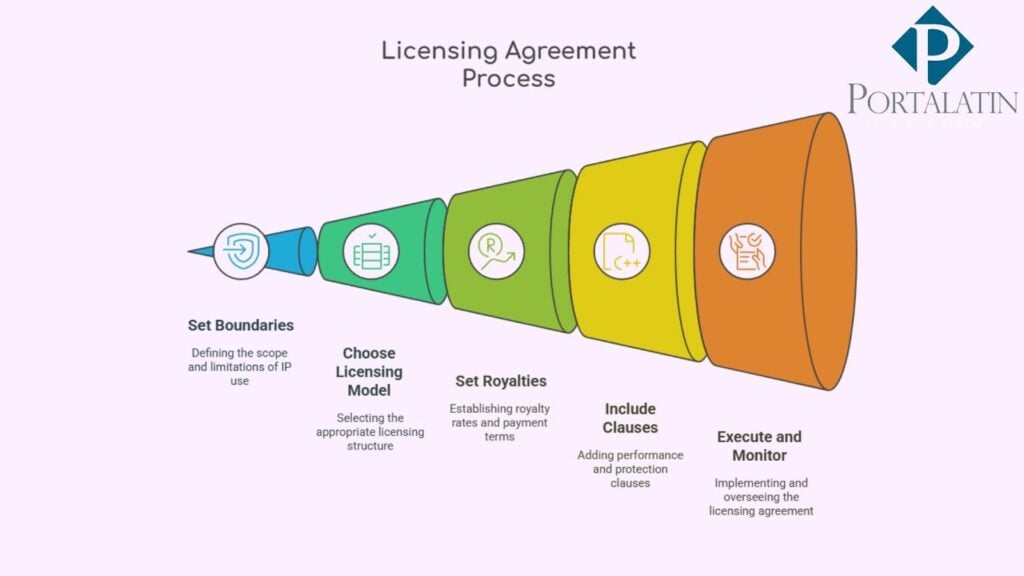A licensing agreement is a written contract that lets one party, the licensor, give another party, the licensee, permission to use a trademark or patent in exchange for royalties.
Global sales of licensed merchandise reached 369.6 billion USD in 2024, a 3.7% rise over the previous year, according to Licensing International’s 2025 Global Study.
Portalatin Business Law Firm keeps that revenue stream safe. Our trilingual team helps businesses register their trademarks and draft the contracts needed in order to have this sort of revenue available.
Key Takeaways
- A licensing agreement lets you profit from your IP while keeping ownership.
- Clear benefits include new markets, recurring royalties, and reduced up-front costs.
- Strong contracts hinge on defined scope, fair royalty terms, and strict audit rights.
What Is a Licensing Agreement?
A licensing agreement is a written contract that lets one party (the licensor) give another party (the licensee) permission to use intellectual property such as a trademark or patent in exchange for money called royalties.
The deal keeps ownership of the trademark or patent with the licensor while letting the licensee legally profit from the IP. Key elements include:
- Two parties: licensor and licensee
- Covers specific IP: brand name, tech, software, design, or content
- Grants limited rights: how, where, and for how long the IP can be used
- Payment: upfront fee, ongoing royalties, or both
- Legal document: enforceable terms, quality controls, and exit options
How Does a Licensing Agreement Work?
The contract sets clear rules so both sides know what to expect. The licensor outlines the scope of use, and the licensee agrees to follow it while paying the agreed-upon fees. Regular audits and quality checks keep the arrangement on track.
Typical workflow:
- Licensor identifies IP and goals (earn revenue, expand reach).
- The licensee requests rights for a market, product line, or region.
- Both negotiate scope, royalty rates, exclusivity, and term length.
- Lawyers draft and sign the contract, each side keeps a copy.
- The licensee uses the IP as agreed and sends royalty reports.
- Licensor monitors quality, audits sales data, and enforces standards.
A clear licensing agreement protects the licensor’s asset, gives the licensee a trusted brand or technology, and outlines how money changes hands.
Why Choose a Licensing Agreement in 2025? 5 Benefits for IP Owners
- Earn predictable, margin-friendly cash flow. Standard royalty bands range from 3 to 7% for consumer goods and up to 15% for tech, putting recurring revenue on autopilot.
- Scale globally with low risk. Pharmaceutical licensing deals alone grew 13% between 2017 and 2021 as firms used partnerships to enter new markets quickly and fill patent-cliff gaps, without heavy capital spend.
- Strengthen brand visibility. Licensees handle manufacturing, marketing, and retail shelf space, so licensors gain exposure of their IP in channels they don’t currently serve, often at no up-front cost.
- Leverage partner experience. A well-matched licensee brings distribution networks, localized know-how, and compliance knowledge that shorten time-to-market for new products.
Top Risks & How to Mitigate Them
- Brand dilution through counterfeits. Fake goods represented $467 billion in 2021. Add strict quality-control and audit clauses, plus hologram labels or RFID to curb gray-market leaks.
- Unpaid or under-reported royalties. Require quarterly sales reports, the right to audit, and late-payment penalties pegged to interest rates.
- Territorial channel conflict. Define clear geographic and online boundaries; include carve-outs for direct-to-consumer sales if needed.
- Over-reliance on one licensee. Keep agreements non-exclusive or add performance benchmarks that trigger claw-back rights.
- Regulatory missteps. Insert warranty and indemnity clauses obligating the licensee to meet all safety and labeling rules in each market.
Types of Licensing Agreements Explained
Trademark Licensing
Trademark licensing lets a brand owner lend its name or logo to a manufacturer or retailer.
Software & SaaS Licensing
Software vendors grant usage rights under subscription or perpetual terms. The software licensing management market is expected to grow through 2030.
Key Differences Between Franchising and Licensing:
Franchising extends an entire business model, licensing only transfers IP rights. Knowing these categories helps readers pick the right structure and draft clauses that match real-world deal norms for 2025.
- Control: Franchisors control the brand, business model, and overall system standards to ensure consistency and protect the brand’s reputation. Licensors focus on IP use.
- Fees: Franchises collect an initial franchise fee plus ongoing royalties, licensing usually relies on percentage royalties or a flat fee.
- Regulation: Franchises face specific disclosure laws in many countries; licensing follows general contract and IP law.
- Support: Franchisees get training and marketing systems, licensees run production and sales on their own.
5 Key Clauses Every Licensing Contract Should Include
1. Grant of Rights & Scope
Spell out exactly what the licensee can do with the IP, products, territories, media, and time limit. Anything left vague becomes leverage in court or during renewals.
2. Royalty Structure & Payment Terms
Average royalties sit between 3 and 7 percent of retail sales for most consumer-goods deals, with tech and pharma climbing well into double digits. Put the rate, sales base (gross vs. net), payment frequency, and currency in your contract.
- Add tiered rates that increase once sales milestones kick in.
- Require electronic sales reports in a fixed template.
3. Exclusivity vs. Non-Exclusivity
Define whether the licensee is the sole user or one of many. If you grant exclusivity, set performance targets like units sold, marketing spend, or shelf share, and make failure an automatic ground for downgrade to non-exclusive status.
4. Quality Control & Audit Rights
Lax oversight can cost you the trademark entirely through “naked licensing” abandonment. Keep the brand safe with:
- Right to inspect factories, packaging, and advertising on demand.
- Royalty audits, 85% of licensees have reporting errors, so periodic audits are non-negotiable.
- Remedy ladder: cure period → penalties → termination.
5. Termination & Renewal Conditions
List clear triggers, non-payment, quality breaches, and insolvency, and specify notice periods. Tie renewal options to hitting royalty minimums so underperforming deals sunset automatically.
Step-by-Step Guide to Drafting a Licensing Agreement

Step 1: List Your IP and Set Boundaries
Identify every asset you plan to license, trademark, software code, or patented process, then map where and how it may be used. A narrow scope keeps rights clear and easier to enforce.
Quick checklist:
- Asset title and registration numbers
- Territory (country, platform, or channel)
- Duration
- Permitted uses and prohibited tweaks
Step 2: Pick the Right Licensing Model
Choose between exclusive, non-exclusive, or field-of-use models. Match the choice to business goals: exclusivity fetches higher royalties but locks you to one partner; non-exclusive spreads risk and reach.
Decision cues:
- Market size vs. partner capacity
- Competitive pressure to move fast
- Need for multiple local adaptations
Step 3: Set Royalties and Payment Terms
Most consumer-goods deals land between 3 and 7 percent of wholesale, while tech and pharma often climb into double digits. Factor in advance fees, minimum guarantees, and audit rights to guard income.
Step 4: Lock Down Performance and Protection Clauses
Tie exclusivity to sales targets, add quality-control language, and reserve the right to inspect factories or code repositories. Include indemnities so the licensee shoulders any regulatory fines tied to their production.
Must-have clauses:
- Minimum sales or milestone triggers
- Inspection windows and remediation timelines
- Termination for non-payment or brand misuse
Step 5: Execute and Monitor
Once terms are final, circulate a clean PDF for signature. Use a shared dashboard or royalty-tracking software so reports, payments, and audits stay on schedule.
Launch checklist:
- Signed originals stored in a secure drive
- Calendar reminders for royalty due dates
- Annual clause review to match market shifts
Take the Next Step Toward Safe, Profitable Licensing
Protect your IP, lock in royalties, and move forward with help from Portalatin Business Law Firm. Our trilingual team drafts licensing contracts that fit your goals and shield your brand from copycats. Ready to start? Contact and tell us about your project.


